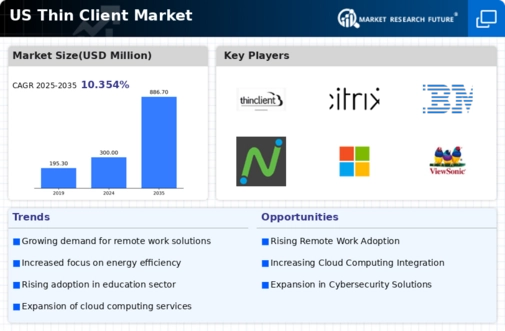Rising Focus on Data Security
In an era where data breaches and cyber threats are prevalent, the thin client market is witnessing a heightened focus on data security. Thin clients inherently offer enhanced security features, as they store minimal data locally and rely on centralized servers for sensitive information. This architecture reduces the risk of data loss and unauthorized access. Recent statistics suggest that organizations utilizing thin clients experience up to 50% fewer security incidents compared to those using traditional PCs. As businesses prioritize safeguarding their data, the adoption of thin clients is likely to increase, thereby bolstering the thin client market.
Advancements in Cloud Computing
The thin client market is significantly influenced by the rapid advancements in cloud computing technologies. As organizations increasingly migrate their operations to the cloud, the need for lightweight, efficient devices becomes paramount. Thin clients are ideally suited for cloud environments, as they require minimal local processing power and rely on centralized servers for applications and data storage. This shift is reflected in market data, which indicates that cloud-based services are projected to grow at a CAGR of 20% over the next five years. Consequently, the integration of thin clients with cloud solutions is expected to enhance productivity and streamline IT management, thereby driving growth in the thin client market.
Environmental Sustainability Initiatives
The thin client market is increasingly aligned with environmental sustainability initiatives as organizations strive to reduce their carbon footprint. Thin clients consume significantly less energy compared to traditional desktop computers, making them an attractive option for businesses aiming to enhance their sustainability efforts. Data indicates that thin clients can reduce energy consumption by up to 60%, contributing to lower operational costs and a smaller environmental impact. As more companies adopt green policies and seek eco-friendly solutions, the demand for thin clients is likely to grow, further driving the expansion of the thin client market.
Regulatory Compliance and Standardization
The thin client market is also being shaped by the increasing need for regulatory compliance and standardization across various sectors. Organizations are required to adhere to strict data protection regulations, which necessitate the implementation of secure computing solutions. Thin clients facilitate compliance by providing centralized control over data access and storage, making it easier for businesses to meet regulatory requirements. For instance, industries such as finance and healthcare are particularly affected by these regulations, driving the demand for thin clients. As compliance becomes a critical factor in IT decision-making, the thin client market is expected to benefit from this trend.
Growing Demand for Cost-Effective Solutions
The thin client market is experiencing a notable shift towards cost-effective computing solutions. Organizations are increasingly seeking ways to reduce operational expenses, and thin clients offer a compelling alternative to traditional PCs. By centralizing computing resources, businesses can lower hardware costs and minimize maintenance expenses. According to recent data, the average cost of ownership for thin clients can be up to 30% lower than that of traditional desktop systems. This trend is particularly pronounced in sectors such as education and healthcare, where budget constraints are prevalent. As companies continue to prioritize financial efficiency, the demand for thin clients is likely to rise, further propelling growth in the thin client market.




















Leave a Comment